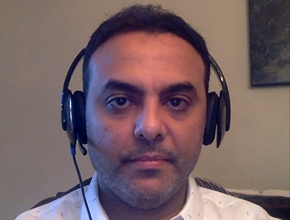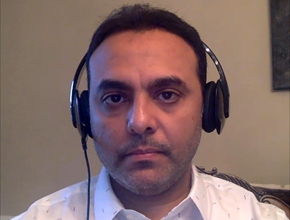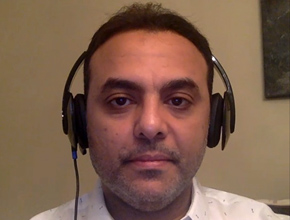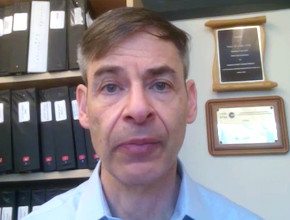Dr Waleed Alhazzani, associate professor in the Division of Critical Care at McMaster University, chair of Surviving Sepsis Campaign (SSC) guidelines, and lead author of the newest SSC guidelines focusing on coronavirus disease 2019 (COVID-19) in the critically ill, explains for Dr Roman Jaeschke recommendations on invasive ventilation, acute respiratory distress syndrome (ARDS) management, and proning.
References
Alhazzani W, Møller MH, Arabi YM, et al. Surviving Sepsis Campaign: guidelines on the management of critically ill adults with Coronavirus Disease 2019 (COVID-19). Intensive Care Med. 2020 Mar 28. doi: 10.1007/s00134-020-06022-5. [Epub ahead of print] PubMed PMID: 32222812; PubMed Central PMCID: PMC7101866.For part 3 of this interview, click here. For part 5, click here.
Roman Jaeschke, MD, MSc: Good morning. Welcome to another part of our McMaster Perspective interview with Professor Waleed Alhazzani. We started to talk about noninvasive ventilation for coronavirus disease 2019 (COVID-19) patients. I think we’ll go to invasive ventilation next, but there was one area we haven’t spoken about: the use of helmets for noninvasive ventilation. Let’s start here.
Waleed Alhazzani, MBBS, MSc: That’s an important and interesting area. From what I know from personal communications, colleagues in Italy use helmet continuous positive airway pressure (CPAP) a lot in these patients. Whether this is helpful and changes the outcome in this group is uncertain.
Roman Jaeschke: A helmet means a hood over the entire head?
Waleed Alhazzani: Yes. It’s a full cover of the head, which neutralizes pressure inside that compartment. The idea is that it makes it easier for patients to tolerate [treatment] and theoretically there may be also less aerosolization, although that’s still not confirmed.
Our colleagues in Italy use helmets all the time because they have them available. In Canada, where I practice, we don’t have them, so I don’t have personal experience with them. But again, we always defer to evidence. There’s one trial that looked at this in the general critically ill population. It showed that helmet use in noninvasive ventilation is promising. However, because of huge uncertainty, we elected not to issue a recommendation for or against using helmet noninvasive ventilation. Although I have to say the general feeling is that it sounds like it may be a good idea.
There is the same caveat as I mentioned before: using noninvasive ventilation and control tidal volumes could induce ventilator-associated lung injury and delay intubation. So I have to stress that whenever noninvasive ventilation is used, you absolutely have to monitor patients for response very closely.
Roman Jaeschke: And it’s difficult to monitor very closely somebody who is generating aerosol around them.
Waleed Alhazzani: Correct.
Roman Jaeschke: Let’s move to invasive ventilation.
Waleed Alhazzani: When patients are intubated, as a clinician you have to decide what’s the most likely mechanism of hypoxemia. Is the most likely mechanism here related to acute respiratory distress syndrome (ARDS)? Or is it related to other mechanisms linked to bad pneumonia without the development of ARDS? The distinction is not very clear and clinically there may be some confusion. Most reports use the Berlin definition [see Acute Respiratory Distress Syndrome] to define ARDS.
Another hint could be that if the patient is on a ventilator and their compliance is not low, then probably the mechanism is not ARDS. Maybe it’s a shunt or perfusion issue. So the management may be a little bit different.
Roman Jaeschke: Could you remind us the Berlin definition of ARDS? Or at least some components?
Waleed Alhazzani: It depends on your PaO2 to FiO2 (P/F) ratio, bilateral infiltrates, and the absence of a cardiogenic cause of pulmonary edema. The patient has to be at least on some positive end-expiratory pressure (PEEP) for those criteria to be met. The severity of ARDS is classified according to the P/F ratio.
Roman Jaeschke: So if you are profoundly hypoxic with bilateral infiltrates, the categorization is not straightforward. You may easily call it ARDS.
Waleed Alhazzani: You’re absolutely right. This is why I personally think that compliance on a ventilator also is a helpful hint. If compliance is not an issue, then the most likely mechanism of hypoxia—regardless of what you see on the x-rays—is probably multifocal bad pneumonia. But once clinicians decide that the most likely mechanism of hypoxia here is ARDS, we issued some recommendations on how to treat those patients. I have to say it’s not much different from other ARDS patients, with a few exceptions.
Roman Jaeschke: Could you summarize them for me?
Waleed Alhazzani: Protective open lung ventilation by targeting low tidal volumes is very important. Using a higher PEEP strategy [is also important]; again, we don’t have a clear threshold to say this is low PEEP and this is higher PEEP. People should use optimal PEEP based on the tests they are comfortable with, whether using the decremental PEEP strategy to decide what PEEP levels they should be using or just follow the ARDS Network protocol and decide what PEEP to use based on this. There are other ways to assess PEEP, but the evidence did not favor one approach over the other. This is why we stayed silent and left it up for clinicians to decide.
In cases of at least moderate to severe ARDS, higher PEEP could be helpful with one important caveat: if the patient does not have ARDS, higher PEEP levels could reduce or impair cardiac output and increase the pressor requirements. So clinicians have to be careful there. In those who don’t respond to higher PEEP, they probably don’t have a recruitable lung and you have to be really careful not to induce barotrauma.
Roman Jaeschke: Have you thought about recruitment maneuvers?
Waleed Alhazzani: We did issue recommendations on recruitment maneuvers. There are 2 types: conventional recruitment maneuvers—CPAP and use of higher pressures for a certain period followed by recruitment of the lung—or the staircase (incremental) PEEP strategy. We know from the evidence that staircase recruitment maneuvers are harmful to patients, so we issued a strong recommendation against using those maneuvers, because you can induce significant harm.
However, in those who are PEEP-responders, it makes sense to use recruitment maneuvers to help with oxygenation. Consider it as a rescue therapy or to improve oxygenation in transient hypoxemia. We made a weak recommendation to use conventional recruitment maneuvers and a strong recommendation against using staircase recruitment maneuvers.
Roman Jaeschke: So conventional maneuvers would be 30 cm of water over 30 seconds or 40 cm of water over 40 seconds rather than going 5-10-15-20 and so forth for periods of time.
Waleed Alhazzani: Correct.
Roman Jaeschke: That’s a change. I believe the last time I’ve seen recruitment maneuvers, the verdict, or balance, was slightly against them. That may be a slight departure. Anything else about ventilation? A big issue, looking at Italy or China, is proning.
Waleed Alhazzani: Correct. Proning is a cheap intervention that does not require devices, although it requires training and comfort of the health-care workers. It’s also associated with its own risks of causing bed sores and dislodgement of the tube. Nevertheless, the body of evidence suggests a mortality benefit in those with severe hypoxemia.
We issued a conditional recommendation for patients with COVID-19 and moderate to severe ARDS to try proning for at least 12 to 16 hours, because studies have shown that this duration is associated with benefit. If you prone for less, the benefit is not as large. But again, it has to be in the context of the most likely physiology being ARDS and the patient having a recruitable lung. It has to make sense clinically to prone those patients.
From communication with colleagues, I know that in China and Italy they use proning quite often in patients with moderate to severe ARDS.
Roman Jaeschke: Any other strategies?
Waleed Alhazzani: Other options that we talked about are inhaled vasodilators. Again, it’s very tricky, because the body of evidence suggests that, at least for nitric oxide, there may be some adverse events, including renal failure, and not much change in clinical outcomes.
As a rescue therapy in those with persistent hypoxemia despite other ventilatory strategy efforts, we think it might be reasonable to use inhaled vasodilators or nitric oxide as a rescue therapy if oxygenation becomes an issue, especially if perfusion is a problem, but with a caveat to assess response. If there’s no quick response in oxygenation, treatment should be tapered off quickly, because of the cost, adverse events, and the fact it’s unlikely the patient will benefit from this strategy if they don’t respond immediately.
Roman Jaeschke: Anything else? Have you spoken about inhaled prostacyclins or prostaglandins?
Waleed Alhazzani: It’s less well studied in ARDS patients. A problem with application of those is that it may require frequent changing of the filters and expose the bedside health-care workers to extra risk, but we said you can use inhaled vasodilators, which include some prostacyclins, as you mentioned. Again, this should be used only in the context of rescue therapy in somebody with refractory hypoxemia just to buy some time.
Roman Jaeschke: Thank you for this part. Maybe we’ll talk about other supportive strategies next time.
Waleed Alhazzani: Thank you.
 English
English
 Español
Español
 українська
українська







